Abstract
STUDY OBJECTIVE--The aim was to determine if there is an association between social network and social support and the CD4 cell count in HIV infected homosexual men. DESIGN--The study was cross sectional. A structured questionnaire assessing psychosocial factors such as social network and social support was administered at interview. Information on CD4 cell counts and HIV symptoms were obtained from participants' medical records. SETTING--The study population consisted of all HIV seropositive homosexual and bisexual men who had not been diagnosed as having AIDS seen at the Department of Infectious Diseases, the only hospital clinic in the city of Malmö (230,000 inhabitants), Sweden that provides care for HIV infected patients. PARTICIPANTS--Altogether 47 (68%) of 69 men in the population agreed to be interviewed. MAIN RESULTS--A low CD4 cell count was found more frequently in men with low social participation scores (OR 3.3; 95% CI 1.0, 11), in those with a low adequacy of social participation (OR 3.8; 95% CI 1.1, 13), and in men with low material support scores (OR 3.9; 95% CI 1.1, 13). After adjustment for age and time of awareness of the HIV infection, the two former associations remained statistically significant. CONCLUSIONS--These results, if reproduced in a longitudinal study, might suggest that psychosocial factors can affect an individual's immune system.
Full text
PDF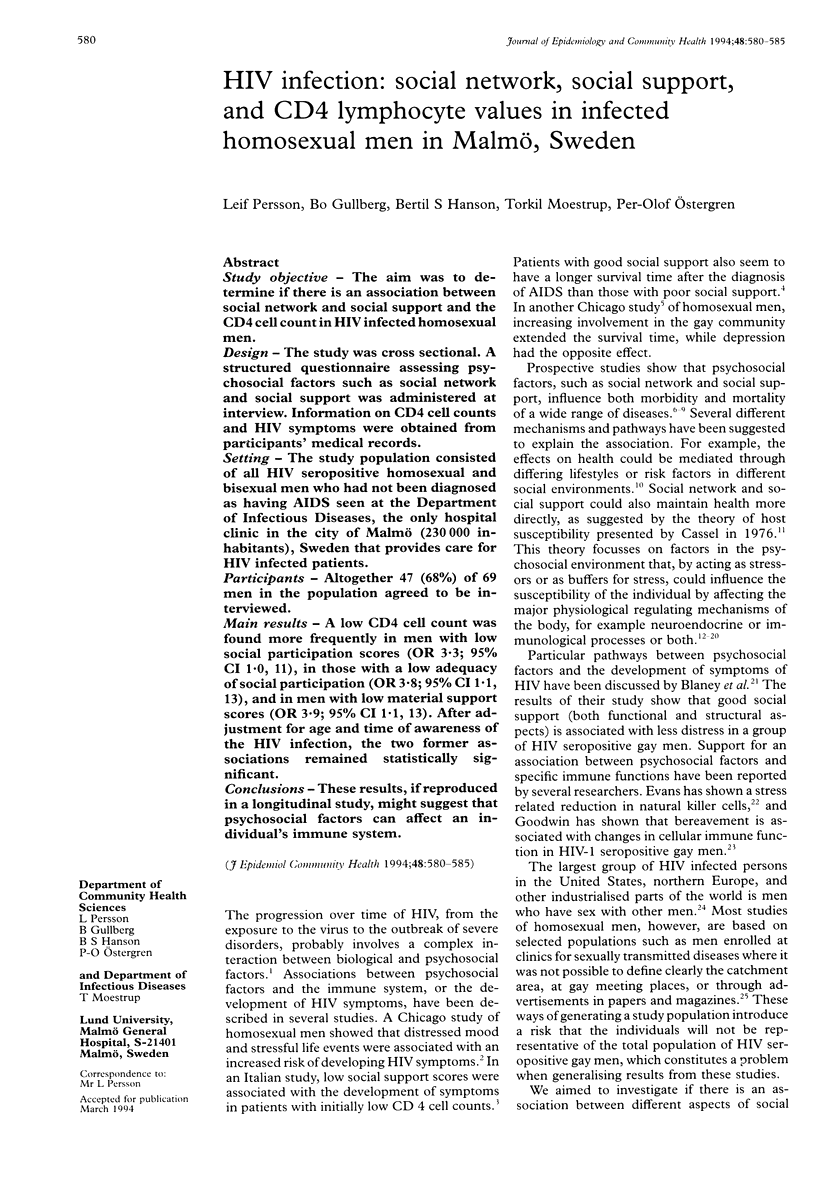
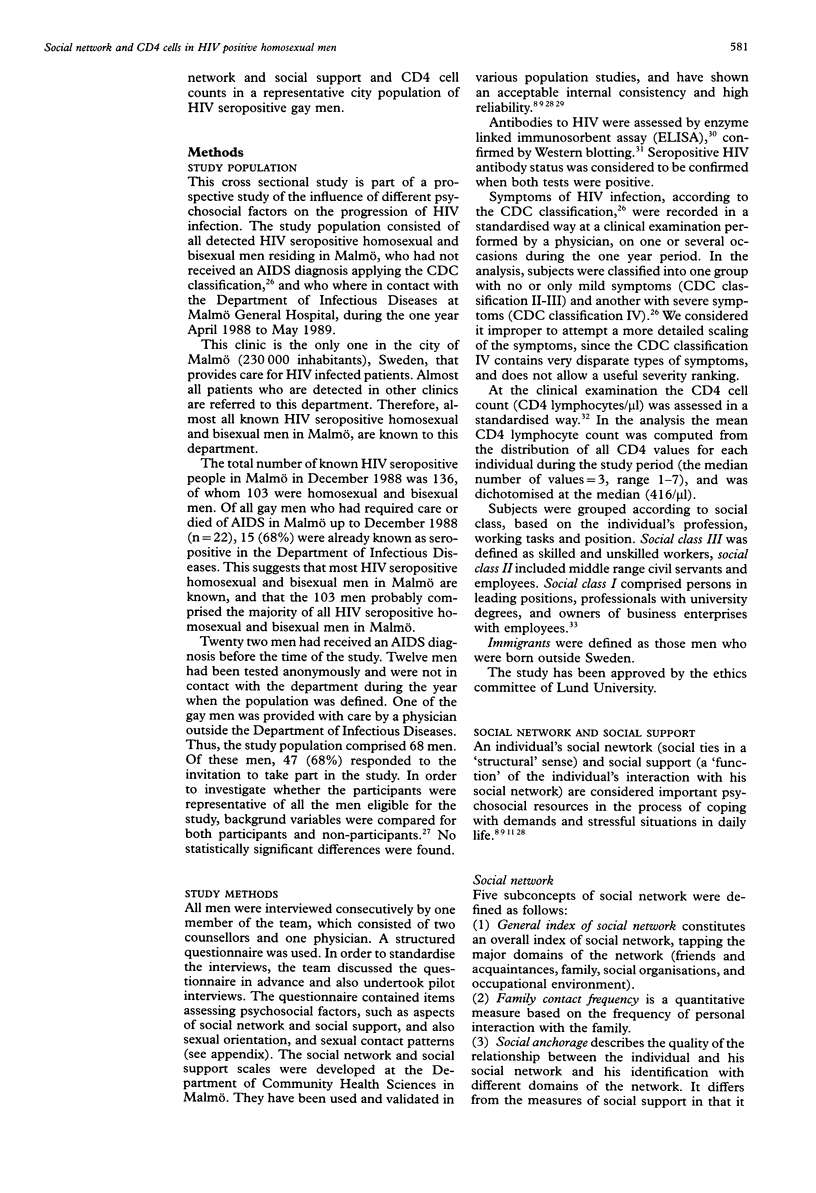
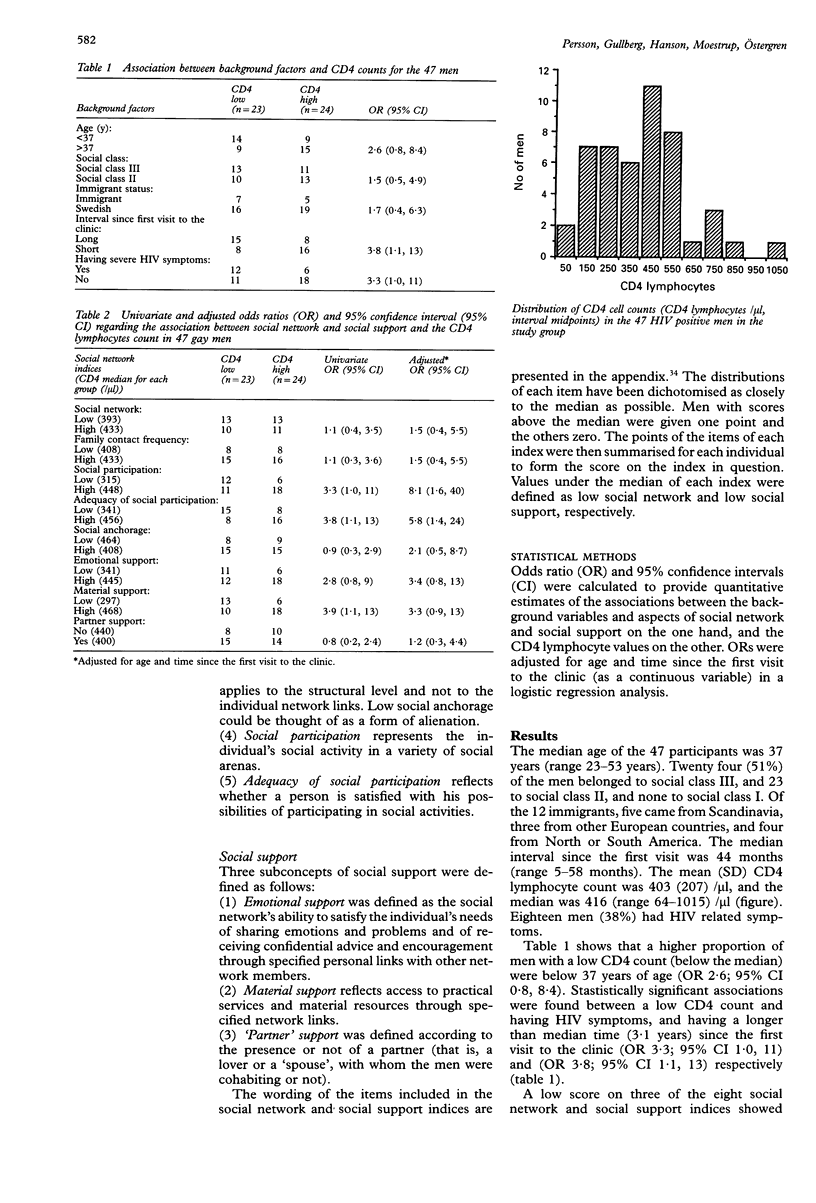
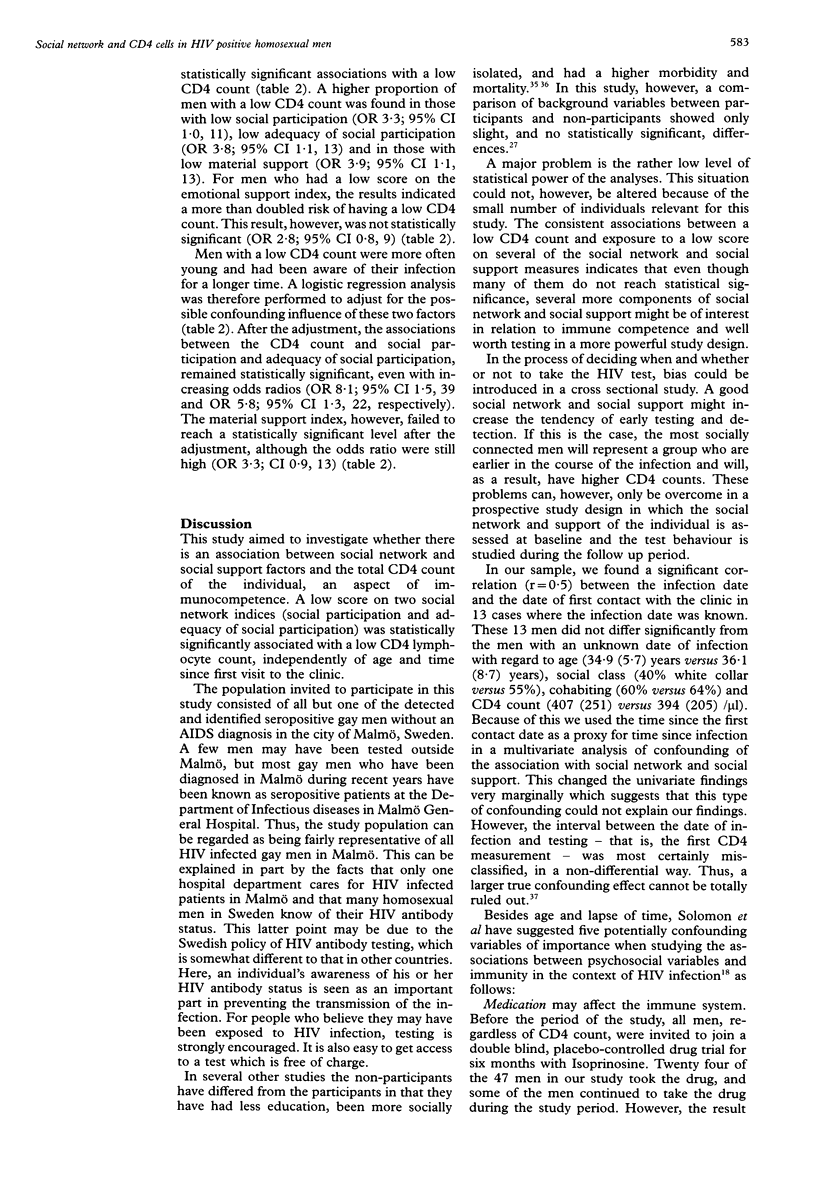
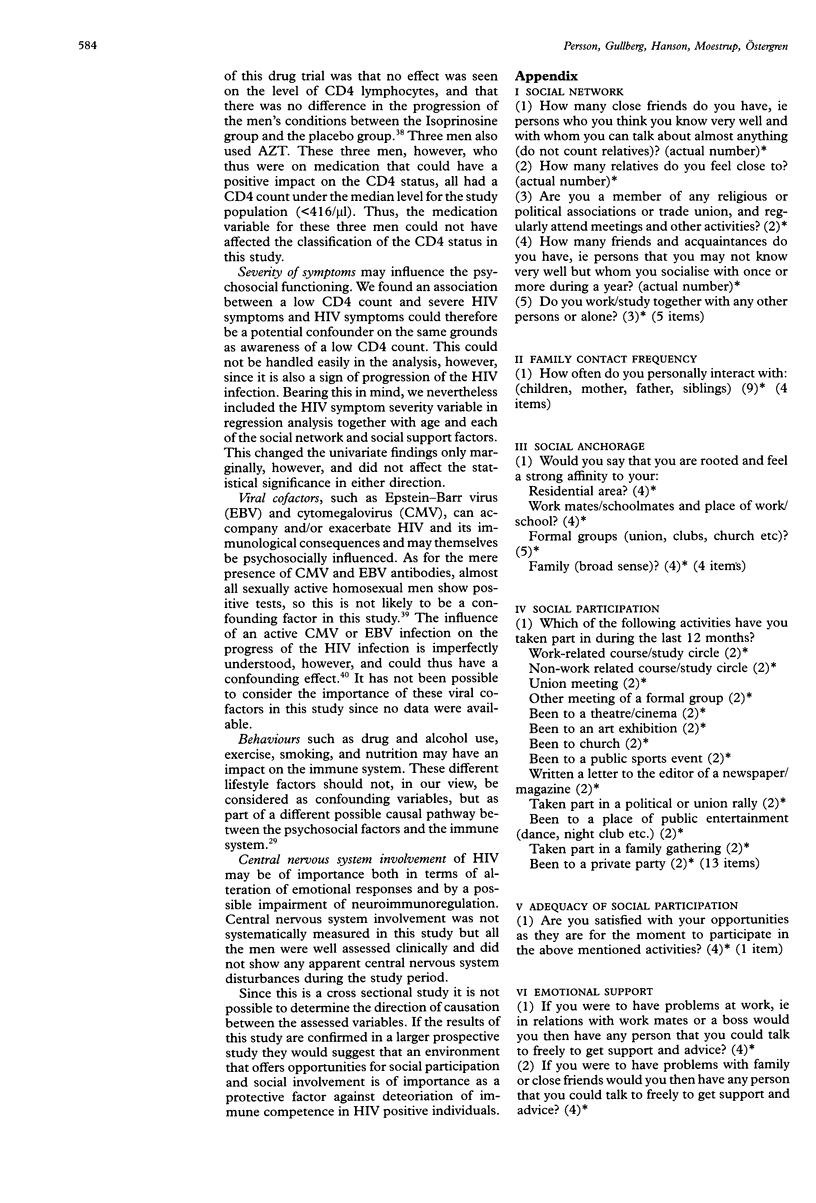
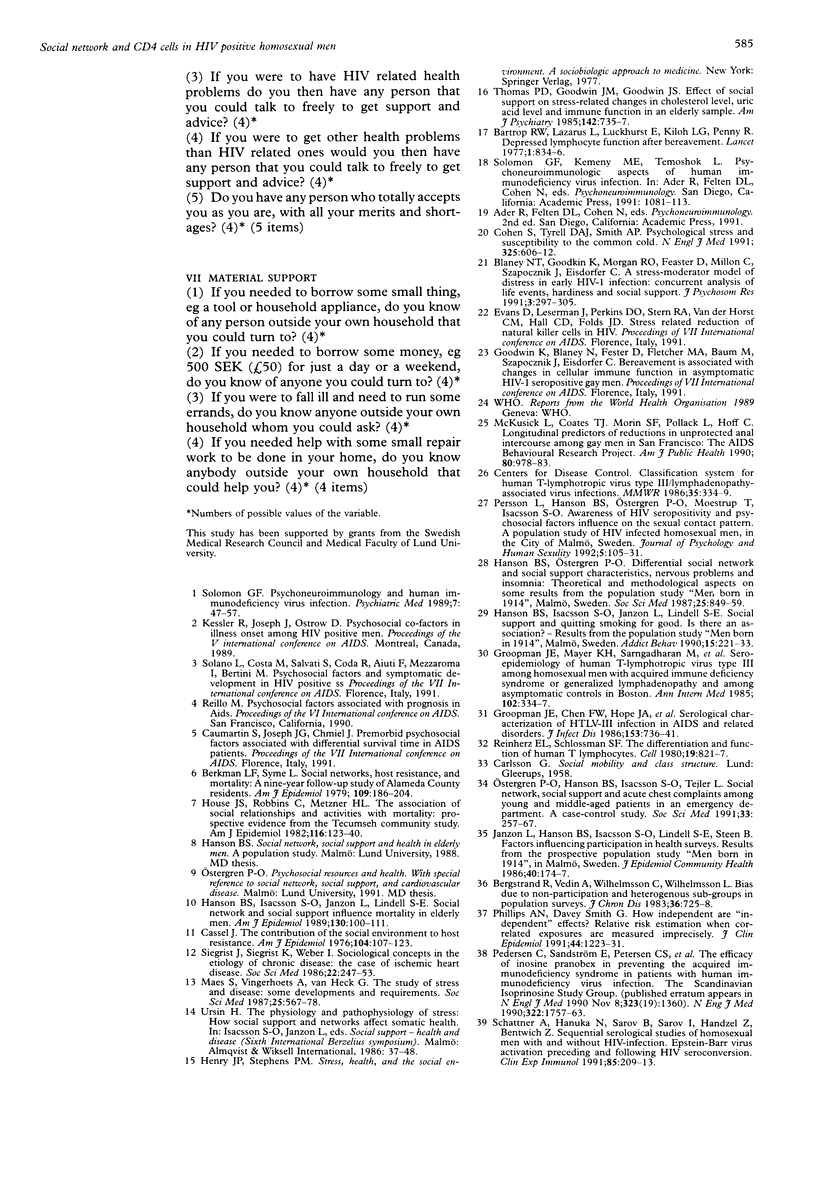
Selected References
These references are in PubMed. This may not be the complete list of references from this article.
- Bartrop R. W., Luckhurst E., Lazarus L., Kiloh L. G., Penny R. Depressed lymphocyte function after bereavement. Lancet. 1977 Apr 16;1(8016):834–836. doi: 10.1016/s0140-6736(77)92780-5. [DOI] [PubMed] [Google Scholar]
- Bergstrand R., Vedin A., Wilhelmsson C., Wilhelmsen L. Bias due to non-participation and heterogenous sub-groups in population surveys. J Chronic Dis. 1983;36(10):725–728. doi: 10.1016/0021-9681(83)90166-2. [DOI] [PubMed] [Google Scholar]
- Berkman L. F., Syme S. L. Social networks, host resistance, and mortality: a nine-year follow-up study of Alameda County residents. Am J Epidemiol. 1979 Feb;109(2):186–204. doi: 10.1093/oxfordjournals.aje.a112674. [DOI] [PubMed] [Google Scholar]
- Blaney N. T., Goodkin K., Morgan R. O., Feaster D., Millon C., Szapocznik J., Eisdorfer C. A stress-moderator model of distress in early HIV-1 infection: concurrent analysis of life events, hardiness and social support. J Psychosom Res. 1991;35(2-3):297–305. doi: 10.1016/0022-3999(91)90084-2. [DOI] [PubMed] [Google Scholar]
- Cassel J. The contribution of the social environment to host resistance: the Fourth Wade Hampton Frost Lecture. Am J Epidemiol. 1976 Aug;104(2):107–123. doi: 10.1093/oxfordjournals.aje.a112281. [DOI] [PubMed] [Google Scholar]
- Cohen S., Tyrrell D. A., Smith A. P. Psychological stress and susceptibility to the common cold. N Engl J Med. 1991 Aug 29;325(9):606–612. doi: 10.1056/NEJM199108293250903. [DOI] [PubMed] [Google Scholar]
- Groopman J. E., Chen F. W., Hope J. A., Andrews J. M., Swift R. L., Benton C. V., Sullivan J. L., Volberding P. A., Sites D. P., Landesman S. Serological characterization of HTLV-III infection in AIDS and related disorders. J Infect Dis. 1986 Apr;153(4):736–742. doi: 10.1093/infdis/153.4.736. [DOI] [PubMed] [Google Scholar]
- Groopman J. E., Mayer K. H., Sarngadharan M. G., Ayotte D., Devico A. L., Finberg R., Sliski A. H., Allan J. D., Gallo R. C. Seroepidemiology of human T-lymphotropic virus type III among homosexual men with the acquired immunodeficiency syndrome or generalized lymphadenopathy and among asymptomatic controls in Boston. Ann Intern Med. 1985 Mar;102(3):334–337. doi: 10.7326/0003-4819-102-3-334. [DOI] [PubMed] [Google Scholar]
- Hanson B. S., Isacsson S. O., Janzon L., Lindell S. E. Social network and social support influence mortality in elderly men. The prospective population study of "Men born in 1914," Malmö, Sweden. Am J Epidemiol. 1989 Jul;130(1):100–111. doi: 10.1093/oxfordjournals.aje.a115301. [DOI] [PubMed] [Google Scholar]
- Hanson B. S., Isacsson S. O., Janzon L., Lindell S. E. Social support and quitting smoking for good. Is there an association? Results from the population study, "Men born in 1914," Malmö, Sweden. Addict Behav. 1990;15(3):221–233. doi: 10.1016/0306-4603(90)90065-6. [DOI] [PubMed] [Google Scholar]
- Hanson B. S., Ostergren P. O. Different social network and social support characteristics, nervous problems and insomnia: theoretical and methodological aspects on some results from the population study 'men born in 1914', Malmö, Sweden. Soc Sci Med. 1987;25(7):849–859. doi: 10.1016/0277-9536(87)90043-8. [DOI] [PubMed] [Google Scholar]
- House J. S., Robbins C., Metzner H. L. The association of social relationships and activities with mortality: prospective evidence from the Tecumseh Community Health Study. Am J Epidemiol. 1982 Jul;116(1):123–140. doi: 10.1093/oxfordjournals.aje.a113387. [DOI] [PubMed] [Google Scholar]
- Janzon L., Hanson B. S., Isacsson S. O., Lindell S. E., Steen B. Factors influencing participation in health surveys. Results from prospective population study 'Men born in 1914' in Malmö, Sweden. J Epidemiol Community Health. 1986 Jun;40(2):174–177. doi: 10.1136/jech.40.2.174. [DOI] [PMC free article] [PubMed] [Google Scholar]
- Maes S., Vingerhoets A., Van Heck G. The study of stress and disease: some developments and requirements. Soc Sci Med. 1987;25(6):567–578. doi: 10.1016/0277-9536(87)90081-5. [DOI] [PubMed] [Google Scholar]
- McKusick L., Coates T. J., Morin S. F., Pollack L., Hoff C. Longitudinal predictors of reductions in unprotected anal intercourse among gay men in San Francisco: the AIDS Behavioral Research Project. Am J Public Health. 1990 Aug;80(8):978–983. doi: 10.2105/ajph.80.8.978. [DOI] [PMC free article] [PubMed] [Google Scholar]
- Ostergren P. O., Hanson B. S., Isacsson S. O., Tejler L. Social network, social support and acute chest complaints among young and middle-aged patients in an emergency department--a case-control study. Soc Sci Med. 1991;33(3):257–267. doi: 10.1016/0277-9536(91)90359-k. [DOI] [PubMed] [Google Scholar]
- Pedersen C., Sandström E., Petersen C. S., Norkrans G., Gerstoft J., Karlsson A., Christensen K. C., Håkansson C., Pehrson P. O., Nielsen J. O. The efficacy of inosine pranobex in preventing the acquired immunodeficiency syndrome in patients with human immunodeficiency virus infection. The Scandinavian Isoprinosine Study Group. N Engl J Med. 1990 Jun 21;322(25):1757–1763. doi: 10.1056/NEJM199006213222501. [DOI] [PubMed] [Google Scholar]
- Phillips A. N., Smith G. D. How independent are "independent" effects? Relative risk estimation when correlated exposures are measured imprecisely. J Clin Epidemiol. 1991;44(11):1223–1231. doi: 10.1016/0895-4356(91)90155-3. [DOI] [PubMed] [Google Scholar]
- Reinherz E. L., Schlossman S. F. The differentiation and function of human T lymphocytes. Cell. 1980 Apr;19(4):821–827. doi: 10.1016/0092-8674(80)90072-0. [DOI] [PubMed] [Google Scholar]
- Siegrist J., Siegrist K., Weber I. Sociological concepts in the etiology of chronic disease: the case of ischemic heart disease. Soc Sci Med. 1986;22(2):247–253. doi: 10.1016/0277-9536(86)90073-0. [DOI] [PubMed] [Google Scholar]
- Solomon G. F. Psychoneuroimmunology and human immunodeficiency virus infection. Psychiatr Med. 1989;7(2):47–57. [PubMed] [Google Scholar]
- Thomas P. D., Goodwin J. M., Goodwin J. S. Effect of social support on stress-related changes in cholesterol level, uric acid level, and immune function in an elderly sample. Am J Psychiatry. 1985 Jun;142(6):735–737. doi: 10.1176/ajp.142.6.735. [DOI] [PubMed] [Google Scholar]


